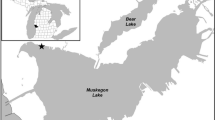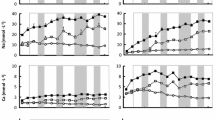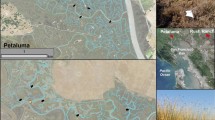Abstract
This study examined the influence of water-level fluctuation (WLF) on sediment–water nutrient exchange in the Laurentian Great Lakes. Water levels in the Laurentian Great Lakes have been below the long-term mean for the past 15 years, causing the exposure of sediments that previously have been either continuously inundated or periodically exposed. The magnitude, duration, and frequency of WLF, as well as land-use history, each can influence the amount and type of sediment–water nutrient exchange. We collected sediment cores from relatively pristine coastal wetlands located on Beaver and Garden Islands in northern Lake Michigan. Sediment cores were taken from different water depths to simulate WLF magnitude; desiccation time was experimentally manipulated to simulate WLF duration. At these relatively pristine wetlands, desiccation time and water depth significantly influenced flux. However, nutrient exchange did not behave in a consistent fashion; phosphorus, nitrate, ammonium, and sulfate flux varied based on sediment exposure history and desiccation time. Sediment–water nutrient exchange rates also were compared to prior measurements taken from more impacted coastal wetlands in southern Lake Michigan and Saginaw Bay in Lake Huron. This comparison revealed a stronger influence of anthropogenic stress than desiccation time, with impacted wetland sediments releasing more soluble reactive phosphorus, sulfate, and ammonium, and retaining more nitrate, than pristine wetlands. Our results indicate that WLFs have the potential to influence sediment–water nutrient exchange, which may influence system productivity, but environmental context can override this influence.










Similar content being viewed by others
References
Akatsuka T, Mitamura O (2011) Response of denitrification rate associated with wetting and drying cycles in a littoral wetland area of Lake Biwa, Japan. Limnology 12:127–135
Albert DA, Wilcox DA, Ingram JW, Thompson TA (2005) Hydrogeomorphic classification for Great Lakes coastal wetlands. J Gt Lakes Res 31(Suppl 1):129–146
Allan JD, McIntyre PB, Smith SDP, Halpern BS, Boyer G, Buchsbaum A, Burton A, Campbell L, Chadderton L, Ciborowski J, Doran P, Eder T, Infante DM, Johnson LB, Joseph CG, Marino AL, Prusevich A, Read J, Rose J, Rutherford E, Sowa S, Steinman AD (2013) Joint analysis of stressors and ecosystems services to enhance restoration effectiveness. Proc Natl Acad Sci 110:372–377
Angel JR, Kunkel KE (2010) The response of Great Lakes water levels to future climate scenarios with an emphasis on Lake Michigan–Huron. J Gt Lakes Res 36:51–58
APHA (1998) Standard methods for the examination of water and waste water, 20th edn. American Public Health Association, Washington
APHA (2005) Standard methods for the examination of water and waste water, 21st edn. American Public Health Association, Washington
Baldwin DS (1996) Effects of exposure to air and subsequent drying on the phosphate sorption characteristics of sediments from a eutrophic reservoir. Limnol Oceanogr 41:1725–1732
Baldwin DS, Rees GN, Mitchell AM, Watson G (2005) Spatial and temporal variability of nitrogen dynamics in an upland stream before and after a drought. Mar Freshw Res 56:457–464
Baron JS, Poff NL, Angermeier PL, Dahm CN, Gleick PH, Hairston NG Jr, Jackson RB, Johnston CA, Richter BG, Steinman AD (2002) Meeting ecological and societal needs for freshwater. Ecol Appl 12:1447–1460
Birch HF (1964) Mineralisation of plant nitrogen following alternate wet and dry conditions. Plant Soil 20:43–49
Boström B, Janson M, Forsberg C (1982) Phosphorus release from lake sediments. Arch Hydrobiol Beih Ergeb Limnol 18:5–59
Bridgham SD, Updegraff K, Pastor J (1998) Carbon, nitrogen, and phosphorus mineralization in northern wetlands. Ecology 79:1545–1561
Chow-Fraser P, Lougheed V, LeThiec V, Crosbie B, Simser L, Lord J (1998) Long-term response of the biotic community to fluctuating water levels and changes in water quality in Cootes Paradise Marsh, a degraded coastal wetland of Lake Ontario. Wetl Ecol Manag 6:19–41
Christian-Smith J, Gleick PH (2012) A twenty-first century US water policy. Oxford University Press, New York
Cooper MJ, Uzarski DG, Burton TM (2007) Macroinvertebrate community composition in relation to anthropogenic disturbance, vegetation, and organic sediment depth in four Lake Michigan drowned river mouth wetlands. Wetlands 27:894–903
Cooper MJ, Steinman AD, Uzarski DG (2013) Influence of geomorphic setting on the metabolism of Lake Huron fringing wetlands. Limnol Oceanogr 58:452–464
Danz NP, Niemi GJ, Regal RR, Hollenhorst T, Johnson LB, Hanowski JM, Axler RM, Ciborowski JJH, Hrabik T, Brady VJ, Kelly JR, Morrice JA, Brazner JC, Howe RW, Johnston CA, Host GE (2007) Integrated measures of anthropogenic stress in the US Great Lakes basin. Environ Manag 39:631–647
Davis WP, Steinman AD (1998) A lightweight, inexpensive benthic core sampler for use in shallow water. J Freshw Ecol 13:475–479
DeBusk WF, Reddy KR (2003) Nutrient and hydrology effects on soil respiration in a northern Everglades marsh. J Environ Qual 32:702–710
Gathman J, Albert D, Burton T (2005) Rapid plant community response to a water level peak in northern Lake Huron coastal wetlands. J Gt Lakes Res 31:160–170
Gilbert JD, Guerrero F, de Vicente I (2014) Sediment desiccation as a driver of phosphate availability in the water column of Mediterranean wetlands. Sci Total Environ 466–467:965–975
IUGLS (International Upper Great Lakes Study) (2009) Public interest advisory group report on public outreach activities. International Joint Commission. http://www.iugls.org/files/tinymce/uploaded/content_pdfs/PIAG_report_final.pdf. Accessed 15 May 2013
IUGLS (International Upper Great Lakes Study) (2012) Lake superior regulation: addressing uncertainty in upper Great Lakes water levels. Final Report to the International Joint Commission. Cat No E95-2/15-2012E
James RT, Havens KE (2005) Outcomes of extreme water levels on water quality of offshore and nearshore regions in a large shallow subtropical lake. Arch Hydrobiol 163:225–239
Jarvis P, Rey A, Petsikos C, Wingate L, Rayment M, Pereira J, Banza J, David J, Miglietta F, Borghetti M, Manca G, Valentini R (2007) Drying and wetting of Mediterranean soils simulates decomposition and carbon dioxide emission: the “Birch effect”. Tree Phys 27:919–940
Kelley JC, Burton TM, Enslin WR (1985) The effects of natural water level fluctuations on N and P cycling in a Great Lakes marsh. Wetlands 4:159–175
Krantzberg G, DeBoer C (2008) A valuation of Great Lakes ecological services in the Laurentian Great Lakes basin with an emphasis on Canada. J Am Water Works Assoc 100:100–110
Kratina P, Greig HS, Thompson PL, Carvalho-Pereira TSA, Shurin JB (2012) Warming modifies trophic cascades and eutrophication in experimental freshwater communities. Ecology 93:1421–1430
Larsen JH, Trebitz A, Steinman AD, Wiley MJ, Carlson-Mazur M, Pebbles V, Braun H, Seelbach P (2013) Great Lakes rivermouth ecosystems: scientific synthesis and management implications. J Gt Lakes Res 39:513–524
Lofgren B, Gronewold A (2012) Water resources. In: US National Climate Assessment Midwest Technical Input Report. (Coordinators: Winkler J, Andresen J, Hatfield J, Bidwell D, Brown D). Available from the Great Lakes Integrated Sciences and Assessments (GLISA) Center, http://glisa.msu.edu/docs/NCA/MTIT_WaterResources.pdf
Lucassen ECHET, Smolders AJP, Roelofs JGM (2005) Effects of temporary desiccation on the mobility of phosphorus and metals in sulphur-rich fens: differential responses of sediments and consequences for water table management. Wetl Ecol Manag 13:135–148
McClain ME, Boyer EW, Dent CL, Gergel SE, Grimm NB, Groffman PF, Hart SC, Harvey JW, Johnston CA, Mayorga E, McDowell WH, Pinay G (2003) Biogeochemical hot spots and hot moments at the interface of terrestrial and aquatic ecosystems. Ecosystems 6:301–312
McGowan S, Leavitt PR, Hall RI (2005) A whole-lake experiment to determine the effects of winter droughts on shallow lakes. Ecosystems 8:694–708
Milliman JD, Farnsworth KL, Jones PD, Xu KH, Smith L (2008) Climatic and anthropogenic factors affecting river discharge to the global ocean, 1951–2000. Glob Planet Change 62:187–194
Murdoch PS, Baron JS, Miller TL (2000) Potential effects of climate change on surface-water quality in North America. J Am Water Res Assoc 36:347–366
Niemi GJ, Kelly JR, Danz NP (2007) Environmental indicators for the coastal region of the North American Great Lakes: introduction and prospectus. J Gt Lakes Res 33(3):1–12
Noe GB, Hupp CR, Rybicki NB (2013) Hydrogeomorphology influences soil nitrogen and phosphorus mineralization in floodplain wetlands. Ecosystems 16:75–94
O’Brien JM, Hamilton SK, Kinsman-Costello LE, Lennon JT, Ostrom NE (2012) Nitrogen transformations in a through-flow wetland revealed using whole-ecosystem pulsed 15N additions. Limnol Oceanogr 57:221–234
Olila OG, Reddy KR, Stites DL (1997) Influence of draining on soil phosphorus forms and distribution in a constructed wetland. Ecol Eng 9:157–169
Paerl HW, Huisman J (2008) Blooms like it hot. Science 320:57–58
Pant HK, Reddy KR (2003) Potential internal loading of phosphorus in a wetland constructed in agricultural land. Water Res 37:965–972
Prudhomme C, Giuntoli I, Robinson EL, Clark DB, Arnell NW, Dankers R, Fekete BM, Franssen W., Gerten D, Gosling SN, Hagemann S, Hannah DM, Kim H, Masaki Y, Satoh Y, Stacke T, Wada Y, Wisser D (2013) Hydrological droughts in the 21st century, hotspots and uncertainties from a global multimodal ensemble experiment. Proc Natl Acad Sci. doi:10.1073/pnas.1222473110
Qiu S, McComb AJ (1994) Effects of oxygen concentration on phosphorus release from reflooded air-dried wetland sediments. Aust J Mar Freshw Res 45:1319–1328
R Development Core Team (2008) R: a language and environment for statistical computing. R Foundation for Statistical Computing, Vienna. http://www.R-project.org
Reddy KR, D’Angelo EM (1997) Biogeochemical indicators to evaluate pollutant removal efficiency in constructed wetlands. Water Sci Tech 35:1–10
Reddy KR, Kadlec RH, Flaig E, Gale PM (1999) Phosphorus retention in streams and wetlands: a review. Crit Rev Environ Sci Tech 29:83–146
Schönbrunner IM, Preiner S, Hein T (2012) Impact of drying and re-flooding of sediment on phosphorus dynamics of river-floodplain systems. Sci Total Environ 432:329–337
Sierzen ME, Peterson GS, Trebitz AS, Brazner JC, West CW (2006) Hydrology and nutrient effects on food-web structure in ten Lake Superior coastal wetlands. Wetlands 26:951–964
Sierzen ME, Morrice JA, Trebitz AS, Hoffman JC (2012) A review of selected ecosystem services provided by coastal wetlands of the Laurentian Great Lakes. Aquat Ecosyst Health Manag 15:92–106
Smith RL (1991) EPA region 3 guidance on handling chemical concentration data near the detection limit risk assessments. Environmental Protection Agency
Sparling GP, Whale KN, Ramsay AJ (1985) Quantifying the contribution from the soil microbial biomass to the extractable P level of fresh and air-dried soils. Aust J Soil Res 23:613–621
Steinman AD, Nicholas JR, Seelbach P, Allan J, Ruswick F (2011) The role of science in developing policy for the use of groundwater in the state of Michigan. Water Policy 13:69–86
Steinman AD, Ogdahl ME, Weinert M, Thompson K, Cooper MJ, Uzarski DG (2012) Water level fluctuations and sediment-water nutrient exchange in Great Lakes coastal wetlands. J Gt Lakes Res 38:766–775
Trebitz AS (2006) Characterizing seiche and tide-driven daily water level fluctuations affecting coastal ecosystems of the Great Lakes. J Gt Lakes Res 32:102–116
US EPA (1983) Methods for chemical analysis of water and wastes. EPA-600-14-79-020. US Environmental Protection Agency, Cincinnati
Uzarski DG (2009) Wetlands of large lakes. In: Likens GE (ed) Encyclopedia of inland waters. Elsevier Press, Oxford, pp 599–606
Uzarski DG, Burton TM, Cooper MJ, Ingram JW, Timmermans STA (2005) Fish habitat use within and across wetland classes in coastal wetlands of the five Great Lakes: development of a fish-based index of biotic integrity. J Gt Lakes Res 31(Suppl 1):171–187
Wilcox DA (2004) Implications of hydrologic variability on the succession of plants in Great Lakes wetlands. Aquat Ecosyst Health Manag 7:223–231
Wilcox DA, Meeker JE, Hudson PL, Armitage BJ, Black MG, Uzarski DG (2002) Hydrologic variability and the application of index of biotic integrity metrics to wetlands: a Great Lakes evaluation. Wetlands 22:588–615
Zohary T, Ostrovsky I (2011) Ecological impacts of excessive water level fluctuations in stratified freshwater lakes. Inland Waters 1:47–59
Acknowledgments
This project was funded by a grant from the Center for Scholarly and Creative Excellence at Grand Valley State University while ADS was on sabbatical. The logistical support provided by the staff at the CMU Biological Station on Beaver Island is gratefully acknowledged; special thanks are extended to John Works, Carolyn Works, and John Gordon. We also express our gratitude to Geraldine Nogaro for help with statistical analysis, Hunter Carrick for laboratory assistance, Kurt Thompson for graphics assistance, and two anonymous reviewers for their thoughtful and constructive comments. This is contribution number 40 of the CMU Institute for Great Lakes Research.
Author information
Authors and Affiliations
Corresponding author
Additional information
Handling Editor: Piet Spaak.
Electronic supplementary material
Below is the link to the electronic supplementary material.
Rights and permissions
About this article
Cite this article
Steinman, A.D., Ogdahl, M.E., Weinert, M. et al. Influence of water-level fluctuation duration and magnitude on sediment–water nutrient exchange in coastal wetlands. Aquat Ecol 48, 143–159 (2014). https://doi.org/10.1007/s10452-014-9472-5
Received:
Accepted:
Published:
Issue Date:
DOI: https://doi.org/10.1007/s10452-014-9472-5




